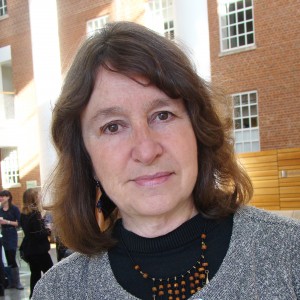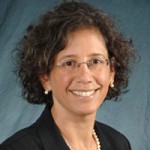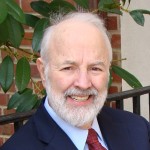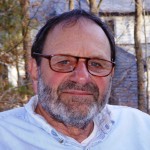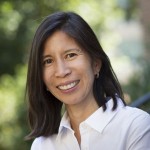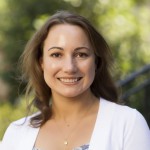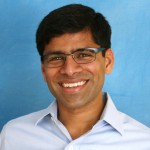Tar heels around the world
December 1, 2014
.
From the School’s earliest days, its faculty members traveled across North Carolina and around the world — solving problems, teaching, extending the School’s reach. Students followed. During World War II, fellowships from the Rockefeller Foundation and other sources increased the influx of foreign students, and veterans from North Carolina — young men and women who had seen the world from a soldier’s vantage point — were arriving at the School, as well.
In the years between 1940 and 1960, hundreds of international students took classes and received degrees from UNC’s public health school. During that time, nearly all faculty members served as consultants to health agencies in developing countries. In the process, they made a curious discovery. The problem with the water source in Kenya needed the same solution as the well in rural North Carolina. The need for access to health care in Bertie County could be addressed with the same type of innovation used by a community in Jakarta. Breastfeeding was as important in Durham as in Tanzania. Local solutions could be applied globally, and ‘global health’ meant there was a world full of local communities trying to find ways to be healthy.
What follows is a compendium of information about some of the faculty members whose research has taken them around the world to improve the lives of millions of people in other countries. What is excellent to remember is that the solutions fit in towns and cities near us, too.
Many early faculty members served as consultants in developing countries or with entities concerned with international health. Lucy Shields Morgan, PhD, who in 1942 was founding chair of the School’s health education department, is an example. During her tenure, she consulted with the World Health Organization and traveled to Iran, India, Burma, Ceylon and Egypt to help develop health education programs. Daniel A. Okun, PhD, Kenan Distinguished Professor, was another pioneer, helping a university in Peru establish a sanitary engineering program in the late 1950s. (Read more about Okun in Earth. Air. Water. Gillings.)
During the 1960s, the School dramatically increased its international health work, a trend that would continue into the 1980s.
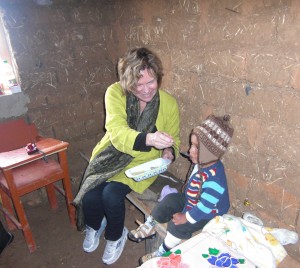
Dr. Peggy Bentley feeds a child in Peru. Taking a break from interviewing the child’s mother about family feeding practices, Bentley introduces a snack prepared with an infant food grinder, a low-tech, inexpensive tool to provide young children with safe, nutritious food. (Photo by Hilary Creed-Kanashiro)
“One of the hallmarks of international health was the idea that U.S. schools would train public health professionals in what were then called developing or ‘third-world’ countries,” says Allan Steckler, DrPH, retired health behavior professor and the School’s first associate dean for global health. The international health approach also focused on developing public health infrastructure in developing countries.
A 1968 addition to the faculty, Guy W. Steuart, PhD, was dedicated both to assisting people in developing countries and increasing the School’s research capabilities. As health behavior department chair, he introduced the Action-Oriented Community Diagnosis (AOCD), a strategy he and other South Africans developed in the pre-apartheid 1940s. It has since become a cornerstone of the School’s approach to community health education.
Like Steuart, health policy and management chair Sagar Jain, PhD, who came to the School from India in 1971 and founded the Journal of World Health and Population, encouraged the faculty to have a more international presence. Jain is now professor emeritus in the department.
Students also had a profound influence on the School’s increasing emphasis on international health. One of these was Robert A. Loddengaard, PhD, who worked for two years in the late 1960s with the U.S. engineering team at Kabul University (Afghanistan). Upon his return to the U.S., he earned a degree in public health administration at the School and later became a faculty member.
Student input regarding the School’s orientation continues to this day.
“Students who had lived and worked abroad were strong advocates for the School’s becoming more globally directed,” Steckler says, adding that students who had served in the Peace Corps were a particularly influential group. (See tinyurl.com/unc-peace-corps.)
The transition from consultation-oriented international health to global health research gathered steam in the late 1990s. The School formalized its commitment to global health in 2003 by establishing the Office of Global Health, with Peggy Bentley, PhD, as director. Bentley, now Carla Smith Chamblee Distinguished Professor of nutrition and associate dean for global health, is a leader in the recently debuted Gillings Global Gateway (sph.unc.edu/ggg), a dynamic unit that organizes and promotes the Gillings School’s global activities in implementation, outreach, global learning and global partnerships.
One of the School’s highly regarded global partnerships is with the U.K.’s University of Cambridge, co-chaired by Gillings School Dean Barbara K. Rimer, DrPH, and Cambridge’s Carol Brayne, MD, MSc, professor and director of the Cambridge Institute of Public Health. The collaboration, begun in 2012, builds on the two universities’ complementary strengths in biostatistics, epidemiology, obesity, noncommunicable diseases, aging, health behavior and global health.
In the first year, with additional support from Drs. Dennis and Mireille Gillings, the partnership committed research funding to dementia, obesity, tobacco and alcohol control policies, and health data gaps that limit understanding of disease progression and treatment. (Learn more at tinyurl.com/unc-cambridge.)
“Global health is a much broader view,” Steckler says. “It includes working abroad doing research. It’s not limited to developing countries — and it’s not just technical assistance, consultation and training.”
Global health includes training American students to work abroad and recognize the interconnection of local and global.
Several factors prompted the change, Steckler says, including UNC’s increasing emphasis on research. Meanwhile, infectious diseases and other health problems became epidemic worldwide. In response, federal and private sources began making funds available to carry out global research on these problems, which included tobacco use, nutrition, obesity, HIV/AIDS and malaria.
School researchers stepped up to investigate these topics. In nutrition, Professor Linda Adair, PhD, studies nutritional stresses among women and children, in part through a large, longitudinal survey in the Philippines that has been ongoing for more than 30 years. Barry Popkin, PhD, W.R. Kenan Jr. Distinguished Professor, initiated the work in 1982, and Adair joined the project in 1986.
Professor Penny Gordon-Larsen, PhD, examines the interplay of ethnicity, disparities, neighborhood and obesity, and Popkin analyzes patterns of diet and physical activity and their health consequences all over the globe. Popkin has studied population-level nutritional changes for more than 30 years in countries as diverse as Mexico, China and Russia. Now, he works with governments in some of these countries, using policy as a tool to change diets. Popkin recently was named to Thomson-Reuters’ list of most widely-cited authors. (See tinyurl.com/most-cited.)
The School is a global leader in HIV/AIDS research. In epidemiology, Professor Emeritus Frieda Behets, PhD, studied HIV/AIDS and other sexually transmitted infections in the Caribbean and sub-Saharan Africa. Myron S. Cohen, MD, Yeargan-Bate Eminent Distinguished Professor of Medicine, Microbiology and Immunology, and Epidemiology, led a groundbreaking study, finding that early antiretroviral treatment almost entirely eliminates HIV transmission in couples. The study was named Science magazine’s “Breakthrough of the Year” in 2011. Associate Professor Annelies Van Rie, MD, PhD, conducts community-based intervention research for tuberculosis and HIV/AIDS.
“One of the big differences between what we now call ‘global health’ and what previously was called ‘international health’ is the idea of global collaboration,” Steckler says.
That shift is evident, for example, in the career trajectory of Bruce Fried, PhD, associate professor of health policy and management, who in the mid-1990s ran management training workshops for directors of clinical epidemiology units in developing countries through the International Clinical Epidemiology Network (INCLEN). Today, his collaborations are truly global — they include joint projects with educational institutions in France, Germany, Kenya and the United Arab Emirates. (See more about Fried in Management and leadership training on a local and global scale.)
Global collaboration also characterizes the projects of many faculty members, including the following.
Anna Maria Siega-Riz, PhD, professor of epidemiology and nutrition and associate dean for academic affairs, coordinates interdisciplinary teams to address problems related to prematurity, racial disparities and obesity.
Dean Harris, JD, clinical associate professor of health policy and management, takes a comparative approach to health systems and health-care regulation.
Rohit Ramaswamy, PhD, clinical associate professor in the Public Health Leadership Program and maternal and child health, helped develop and teach the School’s first Global Implementation Lab. Students work locally and abroad on similar health challenges — among them, clean water, smoking cessation, mental health, and maternal and neonatal care.
Steve Meshnick, MD, PhD, epidemiology professor, collaborates with public health researchers in Malawi and Southeast Asia, developing innovations in malaria surveillance.
Projects that improve disease surveillance globally have potential to save lives locally, Meshnick notes. “Infectious diseases don’t respect borders. Being a global institution helps the Gillings School serve North Carolina, as well,” he says.
Conversely, local projects ultimately can have global impact. Meshnick leads one such project, testing North Carolina-made clothing impregnated with insect repellent to protect outdoor workers from health risks caused by tick-borne diseases.
School faculty members have a distinguished record of acquiring insights and developing methods as they address health problems in one place, and then disseminating those insights and methods to address health problems in other places — including, in many cases, back home in North Carolina.
In the 1980s, Dr. Daniel Okun brought his global expertise to bear on a campaign that ensured clean water for UNC and Chapel Hill. (See page 14.) Likewise, over the decades, UNC public health students have used, in hundreds of North Carolina communities, the Action-Oriented Community Diagnosis approach Guy Steuart brought from South Africa.
The tradition continues:
Jacqueline MacDonald Gibson, PhD, associate professor of environmental sciences and engineering, advised the government of the United Arab Emirates on environmental health risks. Now, she assesses the public health impacts of air pollution and water services disparities in North Carolina.
Jennifer S. Smith, PhD, associate professor of epidemiology, studies human papillomavirus (HPV) and cervical cancer worldwide, with key research sites in China, Kenya and North Carolina.
Members of the Gillings School faculty continue to hone cutting- edge methods to solve global health problems.
A research interest of Harsha Thirumurthy, PhD, assistant professor of health policy and management, is the use of mobile phones to change health behaviors. Other faculty members also study whether such interventions — called mhealth or, more broadly, electronic- or ehealth — can be cheaper and more effective than traditional approaches.
Kate Muessig, PhD, assistant professor of health behavior, uses websites and smart phones to build social support within marginalized groups in China and conducts U.S.-based research to improve vulnerable populations’ access to mental and physical health services.
Vivian Go, PhD, health behavior associate professor, has found innovative ways to influence health behaviors. She analyzes the use of social networks to affect behavior related to HIV prevention among marginalized populations in Vietnam.
Another health behaviorist, assistant 0rofessor Clare Barrington, PhD, has studied social network norms, communication patterns and condom use among the male partners of female sex workers in the Dominican Republic.
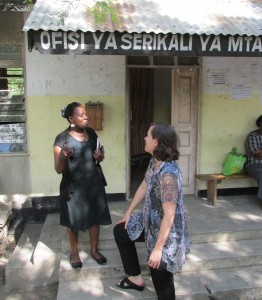
Dr. Susanne Maman, who leads a research project in Tanzania, discuss the logistics of data collection with Lusajo Kajula at a field office in Dar es Salaam.
Suzanne Maman, PhD, health behavior associate professor, works in several countries to assess creative health behavior intervention strategies that aim to address both HIV/AIDS and gender-based violence. Among those strategies are microfinancing and — in a project on which Audrey Pettifor, PhD, collaborates — community mobilization. Pettifor is associate professor of epidemiology.
A faculty oriented toward global research has had a tremendous impact on the School’s teaching and service.
“We all incorporate aspects of our research into our teaching,” Maman says. “By expanding our global faculty, we’re expanding not just our global research but the global curriculum for our students.”
After students graduate, they don’t have to look far to pursue an interest in global health, Meshnick says, noting that many global health research and drug-development companies are located in North Carolina. “Part of the reason they come here is that UNC generates smart graduate students immersed in global health.”
—Kathleen Kearns
Led from its inception by public health faculty members, MEASURE Evaluation exemplifies the School’s global impact. By providing tools to monitor and evaluate big data related to health, the project has empowered the international community to control the HIV/AIDS, malaria and tuberculosis epidemics. USAID has made MEASURE Evaluation its flagship global health effort in population, health and nutrition. The agency recently awarded the project $180 million for its fourth phase, and additional awards from individual USAID bureaus and missions may bring total funding of that phase to more than $300 million. (See May — October 2014 school news.)
“The fact that UNC leads this project shows that we have a tremendous capacity, not only within the Gillings School but also in our capacity to collaborate,” says Jim C. Thomas, PhD, associate professor of epidemiology and project director. “We’ve put together a team of organizations, each with wide reach and skills.”
The MEASURE Evaluation consortium includes Futures Group, ICF International, John Snow Inc., Management Sciences for Health and Tulane University.
“Within the consortium, there is a high degree of trust,” Thomas says. “When there is a challenge, people come forward and help, which makes for an incredible working environment.” The mutual trust and collaborative spirit also facilitate innovation, he says.
Amy Tsui, PhD, now at Johns Hopkins Bloomberg School of Public Health, initiated MEASURE Evaluation at UNC’s Carolina Population Center in 1997. Under the leadership of Siân Curtis, PhD, research associate professor of maternal and child health, from 2002 to 2012, the project more than tripled in size. It now conducts work in about 30 countries at any given time. During Curtis’s tenure, USAID awarded $181 million for the project’s third phase. That and the project’s most recent award are the two largest in UNC history.
“We have the breadth and depth to manage a project like this,” Thomas says. “We have the experience. Most of our faculty members are in the Gillings School, and we are also able to reach across the university. Because we have had this project such a long time, because it has been sizeable and because it is a collaborative agreement with USAID — which opens doors for us globally — we are able to achieve great things around the world.”
—Kathleen Kearns
Carolina Public Health is a publication of the University of North Carolina at Chapel Hill Gillings School of Global Public Health. To view previous issues, please visit sph.unc.edu/cph.

